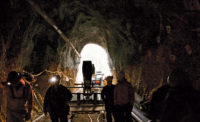The Portland Cement Association is defending its sample ordinance for high-performance buildings despite strong objections from critics and a call to withdraw the proposal. “PCA will continue to promote our concepts and views, work to educate the general public and encourage the adoption of more stringent building-code requirements by state and local jurisdictions for the good of the people and their communities and the environment,” says Stephen S. Szoke, PCA’s director of codes and standards.
The group has “no intention” of withdrawing its recommendation for code changes, says Szoke, the lead author of the controversial document. He says PCA plans to continue working with building, insurance and safety groups to reinforce its proposed requirements.
PCA’s sample ordinance, High Performance Building Requirements for Sustainability, is intended to exceed minimum building requirements of the International Building Code. The document is for “persons to submit to state and local governmental adoption processes,” says Szoke.

DIRECTOR OF CODES AND STANDARDS
Critics call the document, intended to promote concrete, an endrun around the consensus model-code development process thinly disguised as a model for high-performance buildings. Sources take issue not only with the content of the document, which offers additions and amendments to the IBC related to high-performance buildings, but with the process of its creation. PCA purposely developed the document without going through the usual consensus process for standards and model codes
“We have concerns about [PCA’s] work on model building code language that is meant to supplement the IBC,” says a spokesman for the International Code Council, which publishes the IBC. “This type of activity could lead to a more fragmented system of building regulations that will ultimately drive up cost and reduce compliance and safety,” says the spokesman, adding that ICC is talking to PCA about its concerns.
The specifics of the document aside, the American Institute of Architects does not support “wholesale” changes to the IBC outside the established consensus process, says AIA.
PCA’s rival, the American Institute of Steel Construction, is calling for PCA to withdraw the document. “We are concerned that modifications to a model building code document were undertaken by representatives of a single special-interest group, in this case the cement industry,” says John P. Cross, an AISC vice president. The open, balanced consensus process for code development “protects the general public from codes and standards that are self-serving,” he says.
PCA calls the document, offered free for download at www.cement.org, a code-change proposal. The group claims it is common practice for code development issues to be available via the Internet to encourage adoption at national, state and local levels. “An example is the activity by the firefighters and fire-sprinkler industry to amend and append state and local codes for mandatory residential fire sprinklers,” says PCA. The group says those amendments were adopted in hundreds of jurisdictions before becoming mandatory in the International Residential Code.
AISC doesn’t buy the explanation. “This document is a cement-industry wishlist that represents a compilation of their many failed code-change proposals,” says Charles Carter, AISC’s vice president and chief structural engineer. “Yet the spin attempts to portray it as a benevolent effort to improve the sustainability of all buildings in the United States.”
The Building Owners and Managers Association concurs. “It is clear that this effort by PCA is fully in line with the campaign that has been waged by a group called The Masonry Alliance, a coalition of concrete and masonry trade groups including PCA, the National Concrete Masonry Association and others, since 2000, to secure major changes to the ICC model building codes that provide a distinct advantage in the regulatory arena for the products provided by their member companies,” says Ron Burton, a BOMA vice president. “These modifications to the IBC also have a tenuous connection to sustainable and energy-efficient construction as their intent is to ensure that masonry and concrete use is increased, or in some cases, is the only material allowed” in certain building types, he says.
PCA’s response is that high-performance buildings, as defined in a report to Congress prepared by the National Institute of Building Sciences, are more than just buildings with good energy performance. High-performance buildings also place a “high emphasis on life safety, property protection, security, aesthetics and community issues,” says PCA.
Even so, some buildings officials are skeptical about the document’s neutrality. Jonathan Siu, Seattle’s principal engineer and building official, says one major change that appears to directly benefit the cement industry is that all buildings housing multifamily occupancies be of noncombustible construction. If adopted, the sample ordinance also would require institutional and residential multifamily buildings to be fully sprinklered.
“This has been a long-standing position of the concrete and masonry industries, which has become more heightened as more of the nation’s elderly population are relocating to multifamily and assisted- living facilities,” says PCA.




Post a comment to this article
Report Abusive Comment